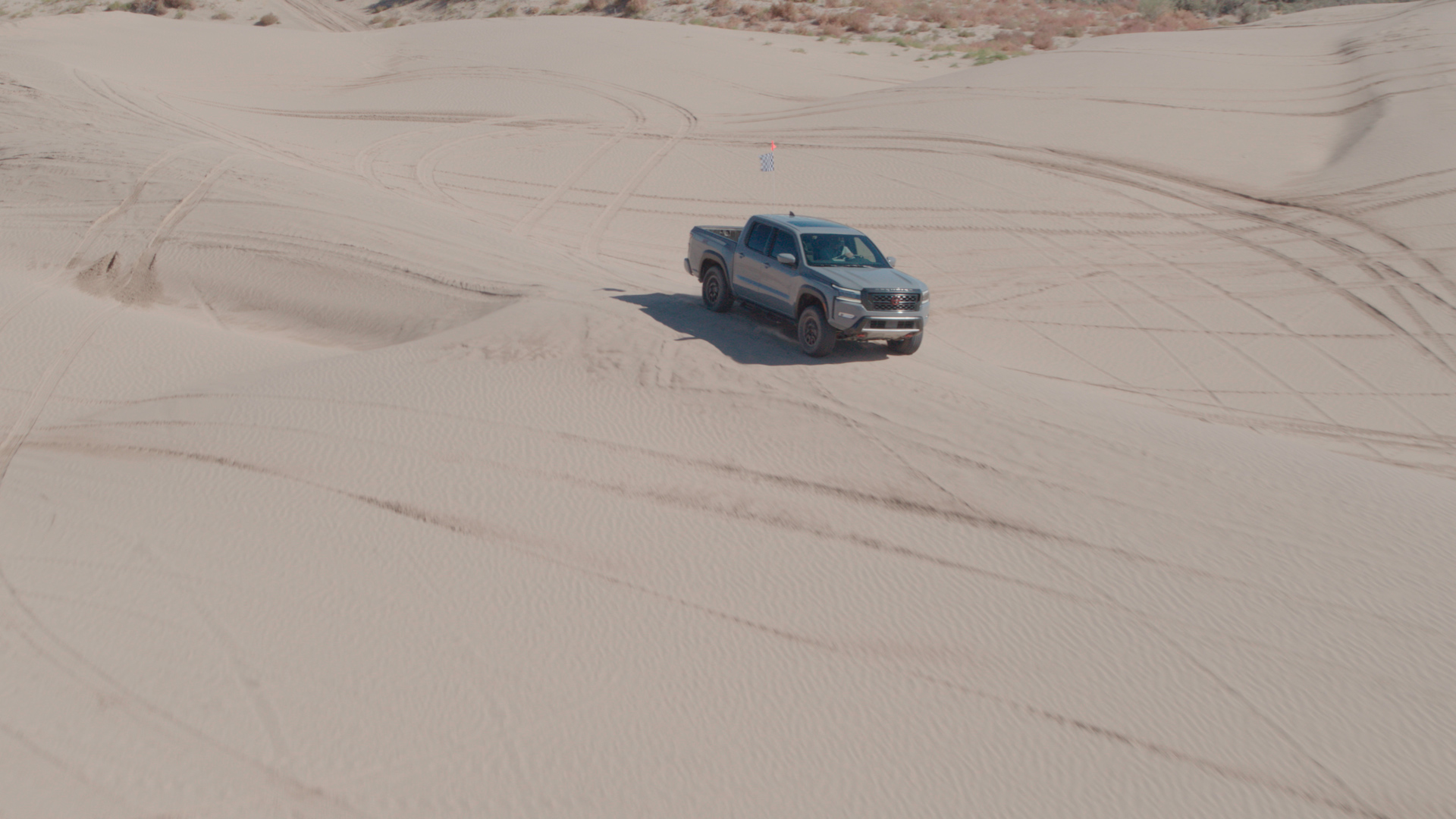If they weren’t just big piles of smashed quartz, you’d swear sand dunes were living creatures. As Marco Polo found out in the Gobi desert, dunes “sing,” or more like whistle, burp, or even bark, as sand grains collide and rub together in the wind. Dunes also grow and reproduce, and even migrate. For example, at Utah’s Little Sahara recreation area—60,000 acres of sand fields and sagebrush flats—the dunes are hightailing it to the northeast at an average of seven feet a year.
Despite its restive nature, Little Sahara’s 124-square-mile dune system offers some of the best ATV-riding action in the country. Sand Mountain, at more than 700 feet high, is the area’s prime terrain feature and a popular hill for sand boarding and skiing. That’s where the team is taking the all-new 2022 Nissan Frontier to sample its power, capability, utility, maneuverability and technology.

This is Where the Road Runs Out, a series of real-world tests of the 2022 Nissan Frontier PRO-4X on typical outdoor adventures. Host TJ Fry is a pro driver, off-roading instructor and self-proclaimed “backwoods boy” who makes his base camp in Montana. An adventure-seeker who has trained the U.S. military’s elite special forces and logged more than 100,000 miles off-road—along with a history of Nissan Hardbody and Frontier ownership—TJ is the right wheelman to put the all-new Frontier through its paces along Utah’s trails, dunes and mountain passes.
“It is beautiful out here,” TJ says as the team sets out for Little Sahara with his skis and ski poles loaded in the new Frontier. “You can see for miles and miles, the sky is clear. We’ve got snow-capped mountains in the distance, and I can’t wait to get this thing onto some sand dunes.”


The drive to Little Sahara starts on pavement, which gives TJ a chance to evaluate the Frontier’s on-road drivability. “This thing really is comfortable. The old Hardbody and the old Frontier that I’ve had definitely were not quiet vehicles, but now Nissan has said, ‘Hey, you know what? Let’s make this more comfortable on the highway as well.’ So they added extra insulation and the acoustic laminated glass in the front doors. I can tell you for sure, it’s making a difference. I’m definitely noticing how much all the little changes add up. And quite frankly, it’s making an overall huge improvement to the livability and drivability of this truck.”
The dirt roads and ATV trails running through Little Sahara’s sagebrush flats give TJ an opportunity to check out the Frontier’s off-road driving dynamics at higher speeds, and experience the benefits of the Frontier’s smaller footprint. “These trails do look like they were more designed for side-by-sides and ATVs than they were for actual vehicles like this,” TJ says, “but the good news is because we have the right-size truck, I’m actually able to squeeze down some of these trails without much problem at all.”

“We’ve got some different surfaces here, some gravel, some sand, and dirt,” TJ says. The Frontier seems to be soaking up all these bumps pretty darn well. I’m not getting thrown around too much. And the zero gravity seats are keeping me put, which is nice.”
Approaching the dunes, Sand Mountain comes into view. With the end of the Ice Age, some 15,000 years ago, came the drying of Lake Bonneville, which once covered 20,000 square miles of the Great Basin. Winds blowing across Utah’s Sevier Desert whipped up the newly exposed sand and deposited it downwind in a massive heap. A heap you can drive—say, a well-equipped pickup truck with four-wheel drive and an electronically locking differential—and ski, on.

With sandy terrain now dominating the drive route, it’s time to air down the Frontier’s tires. “Driving on sand requires lower tire pressures,” TJ says. “That’ll allow the tire to kind of balloon out and give us a larger contact patch. Most of the time, vehicles are running at about 35 psi, the tires are somewhere around there. I’m probably going to end up somewhere down in the 20 to 25 [psi] range, maybe even down in the teens. So it’s really important to make sure that you air the tires back up before you get back on the road.”
The break in the action gives TJ a quiet moment to check out the exterior design. “This truck looks aggressive. I really do like the fact that they’ve got the chiseled fenders. Gives it kind of an aggressive stance. It looks like it’s ready to party. I’m glad it looks like its own vehicle, but still has a lot of the minute touches that tie it into its history.”

Hitting the dunes, the Frontier’s off-road-capable drivetrain gets TJ’s full attention. “The truck’s in 4-[wheel] Low. And normally I would actually be in 4 High for something like this, but because we have nine speeds in this transmission, it really does give us the ability to be in 4 Low and still have some great speed. We’re going to get into some of the bigger dunes. I’m going to bump us up into sixth gear, which means I’m doing the big dunes and I don’t even have to use all nine gears in 4 Low.”

As the production team climbed higher up into the dunes, TJ delivered some of the advice he’d given countless times as an off-road instructor. “Driving off road is all about weight transfer. You can feel the weight moving around in the vehicle. I’m using the brakes to put the weight up front, using the gas to put it in the rear, and the steering wheel to move it from side to side. I’m really impressed with how this truck handles out in the sand.”
